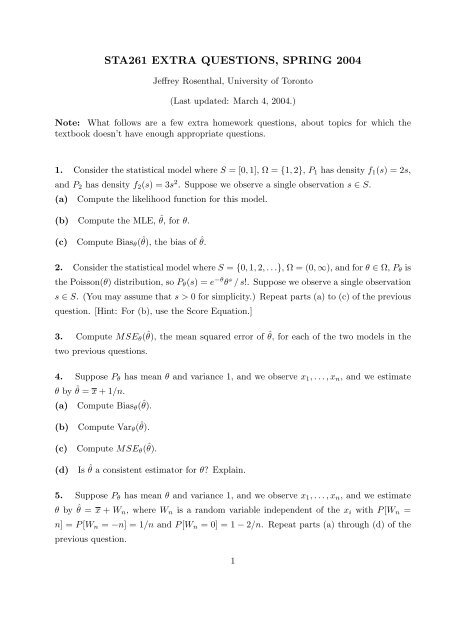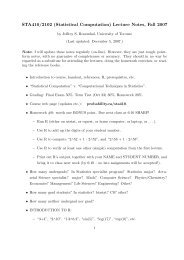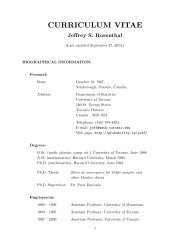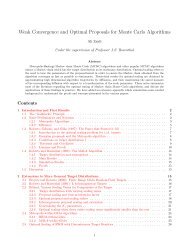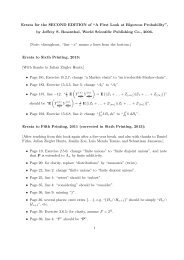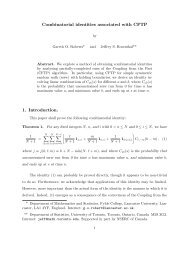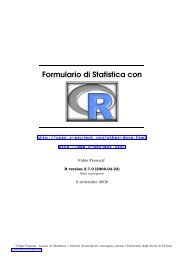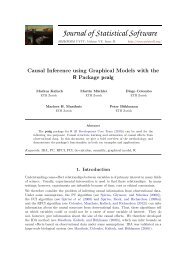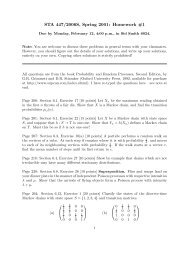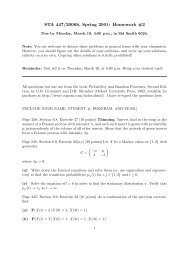Extra Questions #1 and #2 (pdf) - probability.ca
Extra Questions #1 and #2 (pdf) - probability.ca
Extra Questions #1 and #2 (pdf) - probability.ca
Create successful ePaper yourself
Turn your PDF publications into a flip-book with our unique Google optimized e-Paper software.
STA261 EXTRA QUESTIONS, SPRING 2004<br />
Jeffrey Rosenthal, University of Toronto<br />
(Last updated: March 4, 2004.)<br />
Note: What follows are a few extra homework questions, about topics for which the<br />
textbook doesn’t have enough appropriate questions.<br />
1. Consider the statisti<strong>ca</strong>l model where S = [0, 1], Ω = {1, 2}, P 1 has density f 1 (s) = 2s,<br />
<strong>and</strong> P 2 has density f 2 (s) = 3s 2 . Suppose we observe a single observation s ∈ S.<br />
(a) Compute the likelihood function for this model.<br />
(b) Compute the MLE, ˆθ, for θ.<br />
(c)<br />
Compute Bias θ (ˆθ), the bias of ˆθ.<br />
2. Consider the statisti<strong>ca</strong>l model where S = {0, 1, 2, . . .}, Ω = (0, ∞), <strong>and</strong> for θ ∈ Ω, P θ is<br />
the Poisson(θ) distribution, so P θ (s) = e −θ θ s / s!. Suppose we observe a single observation<br />
s ∈ S. (You may assume that s > 0 for simplicity.) Repeat parts (a) to (c) of the previous<br />
question. [Hint: For (b), use the Score Equation.]<br />
3. Compute MSE θ (ˆθ), the mean squared error of ˆθ, for each of the two models in the<br />
two previous questions.<br />
4. Suppose P θ has mean θ <strong>and</strong> variance 1, <strong>and</strong> we observe x 1 , . . . , x n , <strong>and</strong> we estimate<br />
θ by ˆθ = x + 1/n.<br />
(a) Compute Bias θ (ˆθ).<br />
(b)<br />
(c)<br />
(d)<br />
Compute Var θ (ˆθ).<br />
Compute MSE θ (ˆθ).<br />
Is ˆθ a consistent estimator for θ? Explain.<br />
5. Suppose P θ has mean θ <strong>and</strong> variance 1, <strong>and</strong> we observe x 1 , . . . , x n , <strong>and</strong> we estimate<br />
θ by ˆθ = x + W n , where W n is a r<strong>and</strong>om variable independent of the x i with P [W n =<br />
n] = P [W n = −n] = 1/n <strong>and</strong> P [W n = 0] = 1 − 2/n. Repeat parts (a) through (d) of the<br />
previous question.<br />
1
6. Consider the statisti<strong>ca</strong>l model where S = {0, 1, 2, . . .}, Ω = (0, ∞), <strong>and</strong> for θ ∈ Ω, P θ<br />
is the Poisson(θ) distribution, so P θ (s) = e −θ θ s / s!. Suppose we observe the observations<br />
11, 5, 8.5, <strong>and</strong> 7.5. Compute (with explanation) the Method-of-Moments Estimate of θ.<br />
7. Consider the statisti<strong>ca</strong>l model where S = Ω = R, <strong>and</strong> for θ ∈ Ω, P θ = N(2, θ), so<br />
that θ represents the variance (not the mean!). Suppose we observe the observations 3,<br />
−5, 6, <strong>and</strong> −2. Compute (with explanation) the Method-of-Moments Estimate of θ.<br />
8. (Bayesian Inference) Suppose we have one of three dice: either six-sided (so the<br />
numbers {1, . . . , 6} are all equally likely), or eight-sided (so the numbers {1, . . . , 8} are<br />
all equally likely), or ten-sided (so the numbers {1, . . . , 10} are all equally likely), but we<br />
don’t know which one we have. Thus, Ω = {six-sided, eight-sided, ten-sided}. Suppose our<br />
prior distribution on Ω is given by π(six-sided) = 4/7, π(eight-sided) = 1/7, <strong>and</strong> π(tensided)<br />
= 2/7. Compute the posterior distribution for the unknown θ ∈ Ω, for each of the<br />
following <strong>ca</strong>ses:<br />
(a) We observe just one roll, <strong>and</strong> it is a 4.<br />
(b) We observe two rolls, <strong>and</strong> they are 4 <strong>and</strong> 5.<br />
(c) We observe two rolls, <strong>and</strong> they are 4 <strong>and</strong> 7.<br />
9. Let Ω = {1, 2, 3}, with P 1 {5} = 1/2, P 1 {8} = 1/3, P 1 {9} = 1/6, P 2 {10} = 1/2,<br />
P 2 {13} = 1/3, P 2 {14} = 1/6, P 3 {25} = 1/2, P 3 {28} = 1/3, P 3 {29} = 1/6. Suppose we<br />
observe X 1 , . . . , X n . Let D = X − X 1 . Prove that D is ancilliary.<br />
2


